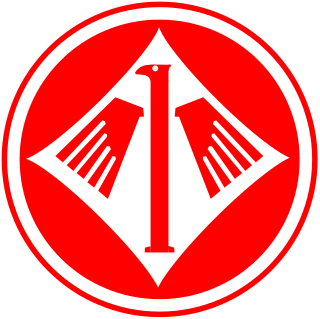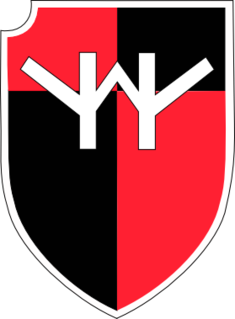Related Research Articles

Adolf Josef Ferdinand Galland was a German Luftwaffe general and flying ace who served throughout the Second World War in Europe. He flew 705 combat missions, and fought on the Western Front and in the Defence of the Reich. On four occasions, he survived being shot down, and he was credited with 104 aerial victories, all of them against the Western Allies.
The second Schweinfurt raid was a World War II air battle that took place on 14 October 1943, over Nazi Germany between forces of the United States 8th Air Force and German Luftwaffe fighter arm (Jagdwaffe). The American bombers conducted a strategic bombing raid on ball bearing factories to reduce production of these vital parts for all manner of war machines. This was the second attack on the factories at Schweinfurt. American wartime intelligence claimed the first Schweinfurt–Regensburg mission in August had reduced bearing production by 34 percent but had cost many bombers. A planned follow-up raid had to be postponed to rebuild American forces.
Big Week or Operation Argument was a sequence of raids by the United States Army Air Forces and RAF Bomber Command from 20 to 25 February 1944, as part of the European strategic bombing campaign against Nazi Germany. The planners intended to attack the German aircraft industry to lure the Luftwaffe into a decisive battle where the Luftwaffe could be damaged so badly that the Allies would achieve air superiority which would ensure success of the invasion of continental Europe.

Jagdgeschwader 27 (JG 27) "Afrika" was a fighter wing of the Luftwaffe during World War II. The wing was given the name "Africa" for serving in the North African Campaign predominantly alone in the period from April 1941 to September 1942. Elements of JG 27 fought in every major theatre of operations in which the Wehrmacht operated.

Jagdgeschwader 1 (JG 1) was a German World War II fighter unit or "wing" which used the Messerschmitt Bf 109 and Focke-Wulf Fw 190 aircraft, between 1940 and 1944. The name of the unit derives from Jagd, meaning "hunt" and Geschwader, meaning "wing". First formed in May 1939 in eastern Prussia, I./JG 1 was one of the original groups created by the Luftwaffe as part of its expansion plans.

Jagdgeschwader 2 (JG 2) "Richthofen" was a German fighter wing during World War II. JG 2 operated the Messerschmitt Bf 109 and Focke-Wulf Fw 190 single-seat, single-engine Interceptor aircraft.

Jagdgeschwader 26 (JG 26) Schlageter was a German fighter-wing of World War II. It was named after Albert Leo Schlageter, a World War I veteran, Freikorps member, and posthumous Nazi martyr, arrested and executed by the French for sabotage in 1923. The wing fought predominantly against the Western Allies.

Wolfgang Späte was a German Luftwaffe fighter pilot during World War II. He was a recipient of the Knight's Cross of the Iron Cross with Oak Leaves. For fighter pilots it was a quantifiable measure of skill and combat success. He is attributed by some, for an early, 1938 version of the speed to fly theory, usually attributed to Paul MacCready. Already a talented glider pilot before the war, he went on to become one of the Luftwaffe's foremost test pilots.

Jagdgeschwader 6 Horst Wessel was a Luftwaffe fighter wing during World War II. Created late in the war as one of the last Jagdgeschwader, JG 6 fought on the Western and Eastern Fronts and in the Defence of the Reich over Germany. This period of the air war was characterised by few successes and heavy losses among the German fighter arm.

The Defence of the Reich is the name given to the strategic defensive aerial campaign fought by the Luftwaffe air arm of the combined Wehrmacht armed forces of Nazi Germany over German-occupied Europe and Nazi Germany during World War II. Its aim was to prevent the destruction of German civilians, military and civil industries by the Western Allies. The day and night air battles over Germany during the war involved thousands of aircraft, units and aerial engagements to counter the Allied strategic bombing campaign. The campaign was one of the longest in the history of aerial warfare and with the Battle of the Atlantic and the Allied Blockade of Germany was the longest of the war. The Luftwaffe fighter force defended the airspace of German-occupied territory against attack, first by RAF Bomber Command and then against the United States Army Air Forces (USAAF).

Günther Specht was a German Luftwaffe fighter ace during World War II.

Eduard Tratt was a Luftwaffe fighter, test pilot and flying ace of World War II. Major Eduard Tratt was the highest scoring Zerstörer pilot of the war with 38 victories and Gruppenkommandeur of II./Zerstörergeschwader 26. He was also a recipient of the Knight's Cross of the Iron Cross with Oak Leaves. The Knight's Cross of the Iron Cross and its higher grade Oak Leaves was awarded to recognise extreme battlefield bravery or successful military leadership. On 20 April 1944 he was posthumously promoted to the rank of Major.
In aerial warfare, the term overclaiming describes a combatant that claims the destruction of more enemy aircraft than actually achieved. The net effect is that the actual losses and claimed victories are unequal.
During the Second World War the German Luftwaffe was the main support weapon of the German Army (Heer). It fought and supported the Wehrmacht's war effort throughout the six years of conflict and contributed to much of Nazi Germany's early successes in 1939–1942. After the turn in Germany's fortunes, it continued to support the German ground forces until the German surrender in May 1945.
Zerstörergeschwader 76 was a Zerstörergeschwader (wing) of the German Luftwaffe during World War II. The wing operated the Messerschmitt Bf 109 in the early phases of World War II, then the Messerschmitt Bf 110 for the duration of the war.

Zerstörergeschwader 26 "Horst Wessel" was a Luftwaffe heavy fighter wing of World War II.
I. Jagdkorps was formed 15 September 1943 in Zeist from the XII. Fliegerkorps and the Luftwaffenbefehlshaber Mitte, and later subordinated to the Luftflotte Reich. The Stab relocated to Brunswick-Querum in March 1944 and to Treuenbrietzen in October 1944. The unit was disbanded on 26 January 1945 and its obligations were taken over by IX.(J) Fliegerkorps.

The Battle of the Heligoland Bight was the first "named" air battle of the Second World War, which began the longest air campaign of the war, the Defence of the Reich. On 3 September 1939, the United Kingdom declared war on Nazi Germany after the German invasion of Poland, which started the European War. The British did not assist Poland by land or sea but RAF Bomber Command flew several missions against German targets. A number of these air raids were directed at Kriegsmarine warships in German ports to prevent their use in the Battle of the Atlantic. With the front lines static between September 1939 and May 1940, a period known as the "Phoney War" set in, with little fighting on land or in the air.

Zerstörergeschwader 1 was a Luftwaffe heavy/destroyer Fighter Aircraft-wing of World War II.

The Messerschmitt Bf 110, often (erroneously) called Me 110, was a twin-engine heavy fighter in the service of the Luftwaffe during World War II. Hermann Göring was a proponent of the Bf 110, and nicknamed it his Eisenseiten ("Ironsides"). Development work on an improved type to replace the Bf 110, the Messerschmitt Me 210 began before the war started, but its teething troubles resulted in the Bf 110 soldiering on until the end of the war in various roles, alongside its replacements, the Me 210 and the Me 410.
References
- ↑ Caldwell & Muller 2007, p. 163.
- Caldwell, Donald; Muller, Richard (2007). The Luftwaffe Over Germany: Defense of the Reich. MBI Publishing. ISBN 978-1-85367-712-0.